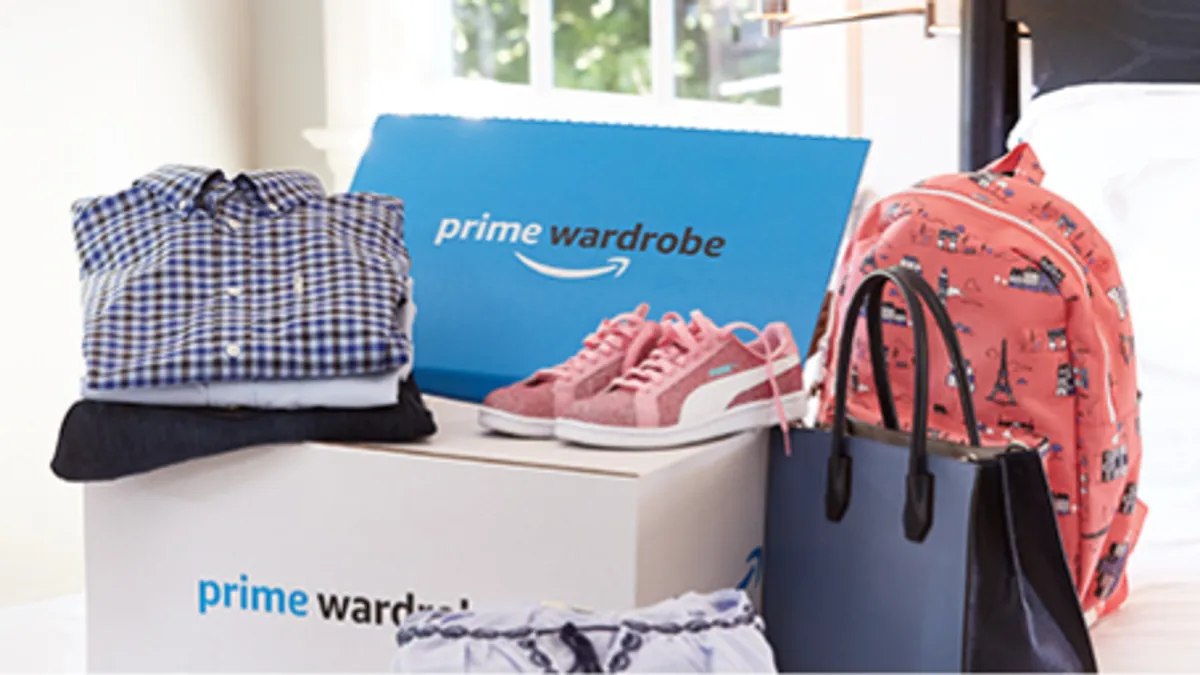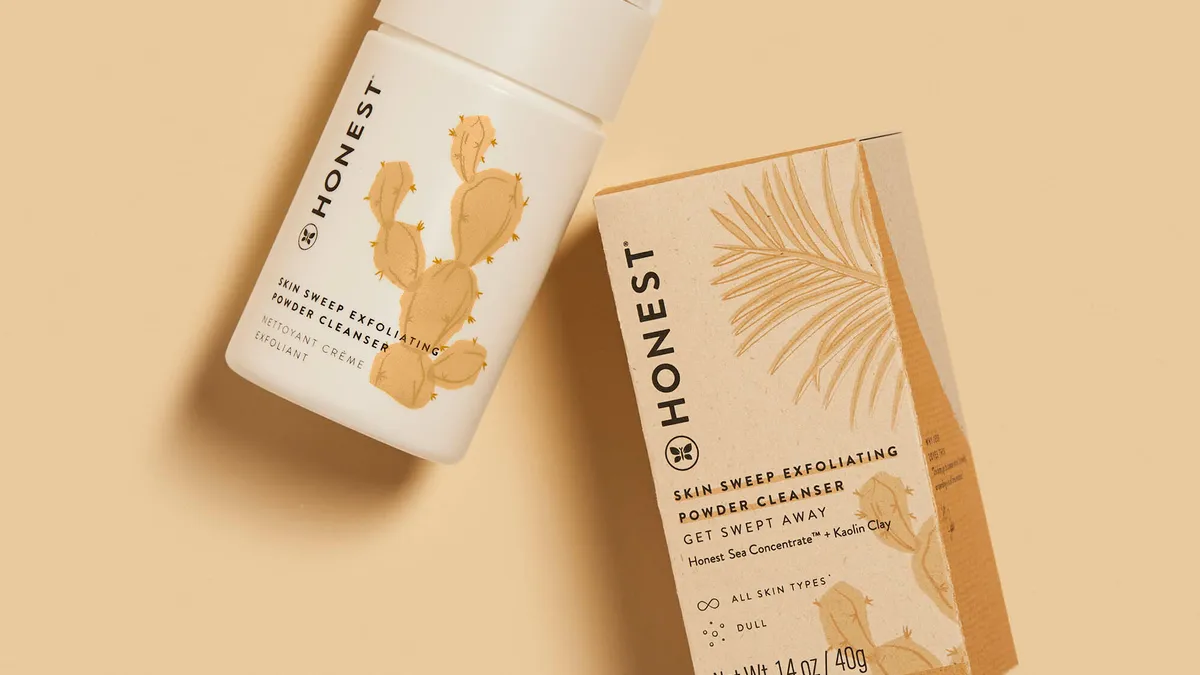Editor's Note: The following is a guest post from Lee Peterson, executive vice president of brand strategy and design at WD Partners. Opinions are his own.
Specialty retailers might believe they’re superior fashion players, but they can’t ignore the apparel industry’s incoming Goliath. Amazon will soon dominate the $217 billion U.S. apparel market. Upending fashion conventions is one thing, volume and scale are another. Can specialty retailers survive Amazon’s rise in apparel?
Sometime this year, Amazon will become the biggest apparel retailer in the U.S. But when it comes to fashion, it’s just not a very good one. Neither is Walmart, by the way, which will be eclipsed by the e-commerce giant to claim the top spot. That’s the tough lesson for the apparel industry — Amazon doesn’t have to be better at fashion to upend the apparel world, it only needs to be 'just ok.' Its rather middling moves into apparel, including such lackluster lines as Peak Velocity and Rebel Canyon, certainly don’t embody superior fashion sensibilities or high-style. No matter, there’s a new sheriff in town.
Despite tons of banal schemata from these giants, specialty retailers have forgotten their role as fashion vanguards. What breakthrough trend or fashion revolution have specialty brands ignited in recent years? Twenty years ago, Gap launched a fashion revolution with its "khakis swing" spot, which aired during Seinfeld’s final episode and reached 76 million viewers. It seems that in order to better compete, specialty could use some more of that.
Amazon’s growth has come swiftly, with staggering share gains — about 1.5% in 2017 alone, or more than $3 billion, according to a recent report by Morgan Stanley. It could be now or never for specialty retailers. Amazon’s clothing and accessory sales could jump 30% this year to $28 billion, according to Cowen & Co. Some analysts even estimate Amazon’s apparel sales could climb to between $45 billion and $85 billion by fiscal 2020.
But Amazon’s growth isn’t the only problem. There’s been a steady decline in overall apparel sales, leaving a lot of robust competitive fighting over an increasingly shrinking pie. Amazon is annexing a big chunk of the apparel market share at a time when American consumers aren’t spending as much on clothing as they once did. In fact, in only four years, spending on apparel has declined from 6.2% of household budgets to only 3.1%.
How has Amazon come to dominate apparel so quickly?
Let’s go back to the beginning. Amazon has been selling apparel lines for other brands through its Marketplace since 2002. But for more than a decade and a half, it mostly enabled apparel sales. Early on, it positioned itself as a partner, not a competitor, luring established apparel brands outside its ecosystem to sell directly to it. As the platform became more popular for apparel sales, it closely watched how consumers bought clothes online.
Then sometime around 2016, Amazon made its move, opting to become an apparel maker itself. An exact date of Amazon’s offensive is hard to pin down because it quickly rolled out approximately seven different fashion lines, with such ignominious brand trademarks as Franklin & Freeman and Franklin Tailored.
Introduced with little fanfare, or even any official announcement, this initial round of experimental launches soon morphed into an all-out barrage of brand introductions in clothing, jewelry, and shoes. Some analysts estimate Amazon has launched at least 50 private-label apparel brands. In May 2017, Amazon hired a heavy-hitter on the fashion side, Christine Beauchamp, who hails from Victoria’s Secret, Ann Taylor and Ralph Lauren, and now heads Amazon’s Fashion Division. It’s been all downhill for them since.
Amazon’s willingness to spend money to gain share has also enabled its fast growth in apparel. In 2007, when Amazon faced competition from online shoe retailer, Zappos, it launched its own shoe site, Endless.com, to compete directly with the nimble upstart. But it couldn’t beat Zappos in the end. When all else failed, Amazon did what it often does when it loses: It bought the competition.
"When Amazon decides it wants to win something and the market's important to it, it will try to compete. If it can't, it will ultimately buy the leader," quipped an executive who had invested in a company acquired by Amazon last year. In 2009, Amazon purchased Zappos for nearly $1 billion and by 2012, Amazon shut down Endless.com.
Amazon’s strategy in apparel isn’t exactly a secret formula. They court major brands, convincing them to migrate to its platform by offering specialty privileges. It’s how they convinced Burberry Group and Levi Strauss & Co. Most importantly, Amazon promised that those who sold directly to it would face less competition from third-party resellers. These brands were also rewarded by having their products featured higher in search results. It is the same playbook deployed to great success in consumer goods, where it now sells private-label versions of such everyday staples as batteries and bath mats under the Amazon Basics banner, first launched in 2009, and also growing fast, rising to an estimated $250 million by 2017.
But such "pay-to-play" deals may be Faustian bargains in the end for apparel brands. For now, most of the volume comes from basics, including T-shirts, jeans and underwear. Amazon isn’t yet selling designer jeans or $50 T-shirts. But what’s to stop Amazon from launching higher-end basics? Prime users are affluent, after all, with average household incomes of $112,000 per year and are driving Amazon's apparel sales.
But Amazon is not invincible. There have been some missteps along the way.
"[Amazon] knows what consumers want in almost every product category and across almost every demographic — men, women, teen, etc. That’s a new kind of competitive threat facing specialty retailers."

In September 2017, the company’s Paris Sunday line, available only to its Prime Members, was discontinued. Despite the aspirational brand name, these were ordinary, bland tops and dresses. But the reliance on such middle-of-the-road offerings doesn’t seem to matter. Amazon is gaining against apparel’s traditional players quite easily and mostly at the expense of traditional department stores, including Sears and Macy’s. (This year, Macy's apparel sales are expected to drop by 4% to $22 billion.) Specialty retailers, including Ascena Retail Group, whose brands include Ann Taylor, Justice and Lane Bryant, L Brands (parent of Victoria’s Secret), Ralph Lauren and Chico’s, have also suffered as Amazon leaps forward.
Despite Amazon’s vulnerabilities, it can see market demand in ways no specialty retailer can. It knows what consumers want in almost every product category and across almost every demographic — men, women, teen, etc. That’s a new kind of competitive threat facing specialty retailers. In each of their respective categories, they have exclusive knowledge about what shoppers want. For specialty apparel retailers content with being just good enough to stay afloat, Amazon is a super formidable foe. Undoubtedly, there will be casualties, with department stores again being the most likely to suffer. (Walmart is one retailer that’s fighting back, notably with the recent launch of four new apparel lines; specialty, take note.)
It’s time for specialty retailers to adopt convention-busting as a way of life.
For one thing, there is no excuse for going to market with a boring store experience. Yet complacency rules. After all, when was the last time a truly innovative retail experience hit the market?
Specialty players have been amazingly laggard for inexplicable reasons and with few exceptions. Van’s, Urban Outfitters and independent Third Wave retailers being the exception. But who is the Abercrombie & Fitch of the 21st Century? Shocking shoppers with half-nude models and noxious fragrance, blasting club music into mall atriums? It might not have been an experience for all or arguably one that would work today, but it was an edgy concept that worked amazingly well at the time.
Chances like that created a very distinct brand identity that carried for over 20 years. What specialty retailer is taking a similar creative leap of faith today? Or more importantly, creating an experience shoppers don’t even know they want yet?
"If specialty retailers try to beat Amazon at its own game they will lose. Amazon is an unbeatable data machine. But the data, no matter how voluminous, is never going to beat a groundbreaking creative concept. The inventive will live forever in an exclusive world."

Data can only suggest your customers don’t want skinny jeans anymore. It won’t create the next fashion breakthrough. It won’t tell you the yet-to-be fashion idea that one day in the future will undermine denim’s stranglehold on casual wear. Only creativity creates what’s next. Data only tells you what’s been.
Given what we know, there is only one defense left against Amazon: Create and introduce breakthrough ideas, fashions and store experiences again. Try something new and fail fast. Listen to the field associates. It’s time to do more than compete for the basics. It’s time to upend the staid and derivative styles dominating the market. Time to render the uber-data obsolete and become a fashion vanguard again.
It’s been a while, but once the noses come out of the books and the fashion eye starts looking around again, true creative spirit will return, and the same old story of Amazon world dominance won’t repeat itself.






















